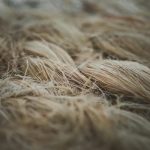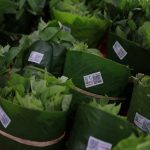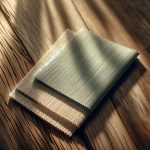When you consider sustainable fabrics, Tencel™ often comes to mind. It’s made from wood pulp sourced from responsibly managed forests, but how is it transformed into such a versatile fiber? The process involves a unique solvent-spinning technique that raises questions about its environmental impact. Is it really as eco-friendly as advertised? Let’s explore the manufacturing steps and uncover the truth behind Tencel™’s closed-loop system.
Table of Contents
Key Takeaways
- Tencel is made from sustainable wood pulp sourced from responsibly managed forests, promoting environmental responsibility and biodiversity.
- The production involves dissolving wood pulp in a non-toxic solvent, preserving cellulose’s natural properties for high-quality fiber.
- A closed-loop manufacturing system is utilized, wherein nearly 99% of solvents are recycled for repeated use, minimizing waste.
- The solvent-spinning process captures and reuses solvents, reducing the need for new chemicals and lowering environmental impact.
- Tencel production uses up to 90% less water than conventional cotton, highlighting its sustainability advantages.
The Source of Tencel: Sustainable Wood Pulp
Tencel, a popular fabric known for its softness and eco-friendliness, originates from sustainable wood pulp.
When you choose Tencel, you’re supporting a process that prioritizes environmental responsibility. The wood pulp comes from trees grown in sustainably managed forests, ensuring minimal impact on ecosystems.
Choosing Tencel means supporting sustainable practices that protect ecosystems and promote responsible forestry.
By sourcing materials this way, manufacturers reduce deforestation and promote biodiversity. You can feel good knowing that the raw materials for Tencel are derived from renewable resources.
The production process also emphasizes efficient use of water and energy, further enhancing its sustainable profile.
Transforming Wood Pulp Into Fiber
Transforming wood pulp into fiber involves a carefully controlled process that assures the final product retains its eco-friendly qualities.
First, the wood pulp is dissolved in a non-toxic solvent, breaking it down into a viscous solution. This process assures that the natural properties of cellulose are preserved, allowing for a high-quality fiber.
Next, the solution is filtered to remove any impurities, assuring consistency in the final product. After filtration, it’s extruded through fine spinnerets, forming continuous strands of fiber.
These strands are then solidified, typically through a water bath, creating the soft, breathable fabric you know as Tencel™. Throughout this process, sustainability is prioritized, minimizing waste and promoting a closed-loop system.
The Solvent-Spinning Process Explained
While many fibers undergo various production methods, the solvent-spinning process used for Tencel™ stands out for its sustainability and efficiency. This method transforms pulped wood into fibers through a series of steps that minimize waste and environmental impact.
Here’s how it works:
- Dissolving: The wood pulp is dissolved in a non-toxic solvent, creating a viscous solution.
- Spinning: This solution is then extruded through spinnerets, forming continuous filaments.
- Regeneration: The solvent is recovered and reused, ensuring minimal environmental harm.
With each step designed to reduce waste, the solvent-spinning process not only produces high-quality fibers but also aligns with sustainable practices, making Tencel™ a responsible choice for conscious consumers.
Understanding the Closed-Loop Manufacturing System
As you explore the production of Tencel™, you’ll find that its closed-loop manufacturing system plays a crucial role in sustainability. This innovative approach minimizes waste and maximizes resource efficiency.
In this system, the solvents used to dissolve wood pulp are captured and reused, reducing the need for new chemicals and lowering environmental impact. You’ll see that nearly 99% of these solvents are recycled, allowing them to be utilized repeatedly throughout the process. This not only conserves resources but also decreases the potential for pollution.
Environmental Advantages of Tencel Production
When you consider Tencel’s environmental impact, sustainable wood sourcing stands out as a key advantage.
The production process also emphasizes water and energy efficiency, making it a more eco-friendly choice.
You’ll see how these factors contribute to a greener textile industry.
Sustainable Wood Sourcing
Tencel’s environmental advantages start with its commitment to sustainable wood sourcing, which guarantees that the raw materials come from responsibly managed forests. This approach not only supports forest conservation but also promotes biodiversity.
When you choose Tencel, you’re contributing to a more sustainable future. Here’s how:
- Responsible Sourcing: Tencel uses wood from certified forests, ensuring trees are harvested sustainably and legally.
- Biodiversity Support: By sourcing from diverse forests, Tencel helps maintain ecosystems and protects wildlife habitats.
- Carbon Footprint Reduction: Sustainable practices in forestry help absorb CO2, mitigating climate change.
Water and Energy Efficiency
While many textiles require significant water and energy during production, Tencel stands out for its efficient processes. You’ll appreciate that Tencel’s production uses up to 90% less water than conventional cotton, making it a smarter choice for the environment.
The closed-loop system recycles water and solvents, minimizing waste and ensuring that resources are used wisely.
Additionally, Tencel’s manufacturing facilities often incorporate renewable energy sources, further reducing their carbon footprint.
Diverse Applications and Benefits of Tencel Fabrics
As you explore the diverse applications and benefits of Tencel fabrics, you’ll discover their remarkable versatility across various industries.
Tencel’s eco-friendly production and softness make it a popular choice for many consumers. Here are three key applications:
- Fashion: Designers love Tencel for its luxurious feel and drape, making it ideal for dresses, blouses, and activewear.
- Home Textiles: Tencel’s breathability and moisture-wicking properties make it perfect for bedding, curtains, and upholstery, enhancing comfort and aesthetics.
- Medical Textiles: Its hypoallergenic nature and biodegradability make Tencel suitable for medical applications, including wound dressings and hospital linens.
With these benefits, Tencel fabrics not only elevate your wardrobe but also contribute positively to the environment.
Frequently Asked Questions
Is Tencel Biodegradable or Compostable?
Yes, Tencel™ is biodegradable and compostable. When you dispose of it properly, it breaks down naturally, returning to the environment without harming ecosystems. You can feel good knowing your choices support sustainability and eco-friendliness.
How Does Tencel Compare to Organic Cotton?
When you compare Tencel to organic cotton, you’ll find Tencel’s production is often more eco-friendly due to its closed-loop process, while organic cotton focuses on avoiding harmful chemicals. Both have unique sustainability benefits worth considering.
Can Tencel Fabrics Be Recycled?
Yes, Tencel fabrics can be recycled. You can return them to recycling programs, where they’re processed into new fibers. This helps reduce waste and supports a more sustainable textile industry, benefiting both you and the environment.
What Certifications Does Tencel Have for Sustainability?
Tencel™ holds several sustainability certifications, like OEKO-TEX® and FSC® certifications. These guarantee the fabric’s production meets environmental standards, promoting responsible sourcing and minimizing ecological impact, so you can feel good about your choices.
Are There Any Allergens in Tencel Fabrics?
Did you know over 60% of people with sensitive skin report fewer reactions to Tencel fabrics? You’ll find Tencel’s hypoallergenic properties make it a great choice, minimizing allergens and offering comfort for everyday wear.
- How to Properly Clean and Maintain Nonwoven Products - July 11, 2025
- A Deep Dive Into Spunbond vs. Spunlace Nonwovens - July 11, 2025
- Nonwoven Wallpaper: Pros, Cons, and Installation Tips - July 11, 2025







